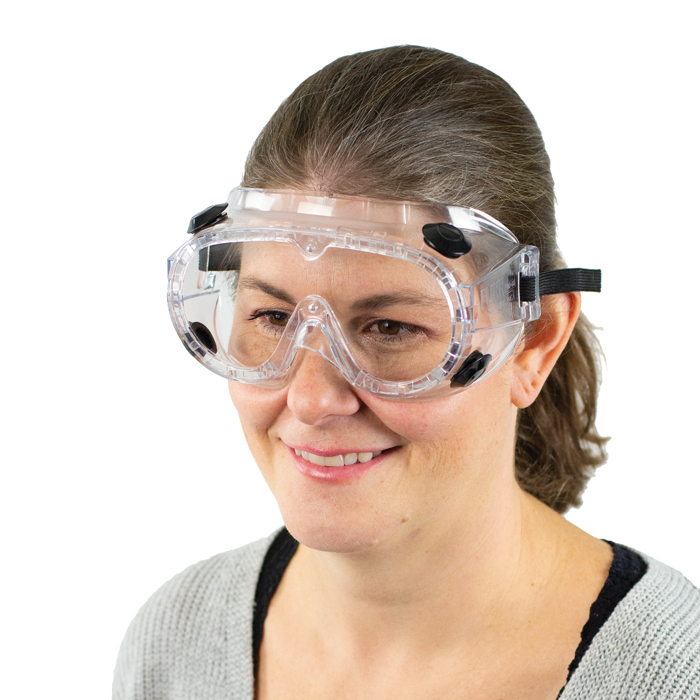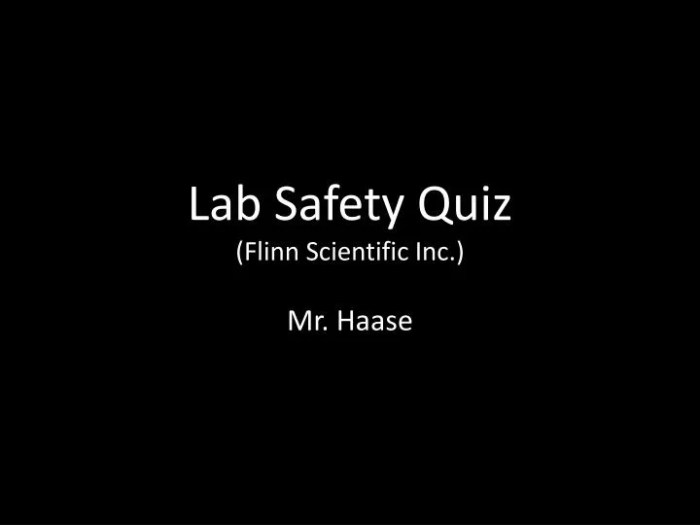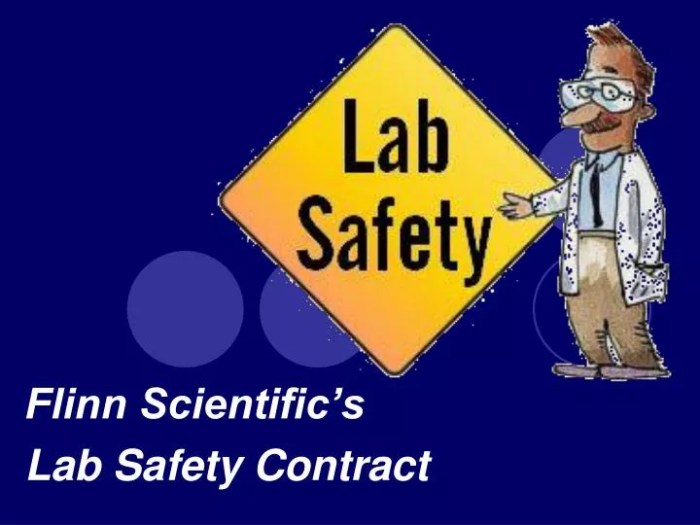Embark on an interactive learning journey with the Flinn Scientific Lab Safety Quiz. This comprehensive quiz assesses your understanding of essential laboratory safety regulations, personal protective equipment (PPE), equipment handling, chemical safety, emergency preparedness, and waste management. Engage with our quiz to sharpen your safety knowledge and ensure a safe and productive laboratory environment.
Safety Regulations and Procedures

Maintaining a safe laboratory environment is paramount to prevent accidents, injuries, and hazards. Adhering to established safety regulations and procedures is crucial for the well-being of individuals and the integrity of research and experiments.
Negligence in following safety protocols can lead to severe consequences, including physical harm, property damage, and compromised experimental outcomes. Moreover, non-compliance may result in disciplinary actions, legal liabilities, and reputational damage.
Common Safety Regulations
Common safety regulations in laboratories include:
- Wearing appropriate personal protective equipment (PPE), such as lab coats, gloves, safety glasses, and closed-toe shoes.
- Maintaining a clean and organized work area, free of clutter and potential hazards.
- Handling chemicals and hazardous materials with care, following proper disposal procedures.
- Reporting any accidents, incidents, or spills immediately to supervisors or designated personnel.
li>Using equipment safely, being aware of potential risks and operating within designated parameters.
Personal Protective Equipment (PPE)

Personal Protective Equipment (PPE) plays a crucial role in minimizing the risks associated with working in a scientific laboratory. It provides a barrier between the wearer and potential hazards, reducing the likelihood of injury or exposure to harmful substances. The proper selection, use, and maintenance of PPE are essential for ensuring the safety of laboratory personnel.
Types of PPE, Flinn scientific lab safety quiz
The specific types of PPE required in a scientific laboratory depend on the nature of the work being conducted and the potential hazards involved. Common types of PPE include:
- Lab coats or coveralls:Protect clothing and skin from spills and splashes.
- Safety glasses or goggles:Shield eyes from flying particles, chemicals, and UV radiation.
- Gloves:Protect hands from chemical exposure, cuts, and abrasions.
- Respirators:Filter out hazardous fumes, gases, and vapors.
- Footwear:Closed-toe shoes or boots with slip-resistant soles prevent slips and falls and protect feet from spills.
Proper Usage and Maintenance of PPE
Properly using and maintaining PPE is crucial for its effectiveness. Wear PPE at all times when working in the laboratory, and ensure it fits correctly. Inspect PPE before each use for any damage or wear and tear. Clean and disinfect PPE regularly, especially after spills or contamination.
Replace damaged or worn PPE promptly.
Consequences of Not Wearing Appropriate PPE
Failure to wear appropriate PPE can have serious consequences. Exposure to hazardous substances can cause skin irritation, burns, respiratory problems, or even systemic toxicity. Accidents can result in cuts, abrasions, or eye injuries. By not wearing PPE, individuals put themselves and others at risk.
Laboratory Equipment and Handling
The scientific laboratory is equipped with a wide range of instruments and materials used for conducting experiments and collecting data. It is essential to familiarize oneself with the proper handling and storage of laboratory equipment to ensure safety and prevent accidents.
Mishandling of equipment can lead to injury, damage to equipment, and compromised experimental results.
Types of Laboratory Equipment
- Beakers: Used for mixing, heating, and storing liquids.
- Flasks: Similar to beakers but with a narrower neck, used for volumetric measurements and reactions.
- Test tubes: Small, cylindrical glass containers used for small-scale reactions and observations.
- Burettes: Graduated glass tubes with a stopcock, used for precise delivery of liquids in titrations.
- Thermometers: Used to measure temperature.
- Microscopes: Used to magnify and observe small objects.
- Centrifuges: Used to separate particles in a solution based on density.
- Balances: Used to measure mass.
li>Pipettes: Graduated glass or plastic tubes used for measuring and transferring small volumes of liquids.
Safe Handling and Storage
Proper handling and storage of laboratory equipment are crucial for safety and longevity of the equipment. Here are some general guidelines:
- Always inspect equipment before use for any cracks, chips, or damage.
- Handle glassware with care to avoid breakage.
- Use equipment only for its intended purpose.
- Never heat glassware directly over an open flame.
- Store equipment in a clean and dry place.
Potential Hazards
Mishandling laboratory equipment can lead to several hazards, including:
- Cuts and lacerations from broken glassware.
- Burns from hot equipment or chemicals.
- Electrical shocks from faulty equipment.
- Fires from flammable chemicals.
- Chemical spills and exposure.
By following proper safety guidelines and handling equipment with care, you can minimize these hazards and ensure a safe laboratory environment.
Chemical Safety

Chemical safety in the laboratory is of utmost importance to prevent accidents, injuries, and health hazards. Understanding the potential risks associated with chemicals and implementing proper safety measures is crucial.
Types of Chemical Hazards
Chemical hazards can be classified into several categories:
- Toxic chemicals:Can cause adverse health effects upon inhalation, ingestion, or skin contact.
- Corrosive chemicals:Can cause severe burns or tissue damage upon contact.
- Flammable chemicals:Can easily ignite and cause fires or explosions.
- Reactive chemicals:Can react violently with other substances, releasing heat, gas, or other hazardous products.
- Carcinogenic chemicals:Can cause cancer upon prolonged exposure.
Handling, Storage, and Disposal of Chemicals
Proper handling, storage, and disposal of chemicals are essential to minimize risks:
- Handling:Wear appropriate personal protective equipment (PPE), follow instructions on Material Safety Data Sheets (MSDSs), and use proper techniques for transferring and mixing chemicals.
- Storage:Store chemicals in compatible containers, in well-ventilated areas, and away from incompatible substances.
- Disposal:Dispose of chemicals according to local regulations, considering their hazardous properties and environmental impact.
Importance of Material Safety Data Sheets (MSDSs)
MSDSs provide vital information on the hazards associated with a chemical, including its toxicity, flammability, reactivity, and proper handling and storage procedures. Understanding and following the information on MSDSs is crucial for ensuring safety in the laboratory.
Emergency Preparedness

Emergency preparedness is essential in any laboratory setting to ensure the safety of personnel and the integrity of the facility. Having an emergency plan in place Artikels the procedures to follow in case of various incidents, enabling a prompt and effective response.
The following table Artikels emergency procedures for common laboratory incidents:
| Incident | Procedure |
|---|---|
| Fire | – Activate the nearest fire alarm.
|
| Chemical spill | – Identify the spilled chemical and its hazards.
|
| Biological spill | – Identify the spilled biological material and its hazards.
|
| Injury | – Assess the severity of the injury.
|
| Gas leak | – Identify the source of the leak.
|
It is crucial to familiarize yourself with the emergency procedures for your specific laboratory and participate in regular emergency drills to ensure a coordinated and efficient response in case of an incident.
Waste Management
Laboratory waste management is a critical aspect of laboratory safety, ensuring the safe and environmentally sound disposal of hazardous materials. Proper waste management practices minimize contamination risks, protect human health, and preserve the environment.
Types of Laboratory Waste
- Chemical waste:Includes acids, bases, solvents, and other hazardous chemicals.
- Biological waste:Contains microorganisms, blood, and other biological materials.
- Radioactive waste:Emits ionizing radiation and requires specialized handling and disposal.
- Sharps waste:Needles, syringes, and other sharp objects that pose a puncture hazard.
- General waste:Non-hazardous materials such as paper, plastic, and glass.
Proper Disposal Methods
Each type of waste requires specific disposal methods to ensure safety and compliance with regulations.
- Chemical waste:Neutralize, dilute, or treat before disposal according to specific chemical properties.
- Biological waste:Autoclave or incinerate to destroy microorganisms.
- Radioactive waste:Dispose through licensed radioactive waste disposal facilities.
- Sharps waste:Place in puncture-proof containers for proper disposal.
- General waste:Dispose in designated waste bins or recycling containers.
Importance of Proper Waste Management
- Prevents contamination:Improper disposal can contaminate the environment, soil, and groundwater.
- Protects human health:Exposure to hazardous waste can cause health risks, including chemical burns, infections, and radiation exposure.
- Preserves the environment:Improper disposal can harm ecosystems and deplete natural resources.
Regulations and Guidelines
Laboratory waste disposal is regulated by various environmental protection agencies and institutions. These regulations set standards for waste classification, disposal methods, and record-keeping to ensure compliance and protect the environment.
Questions and Answers: Flinn Scientific Lab Safety Quiz
What are the consequences of not following laboratory safety protocols?
Consequences can range from minor injuries to severe accidents, environmental contamination, and legal liabilities.
What is the purpose of personal protective equipment (PPE) in a laboratory?
PPE protects individuals from potential hazards such as chemicals, biological agents, and physical injuries.
Why is it important to understand Material Safety Data Sheets (MSDSs)?
MSDSs provide crucial information about chemical hazards, handling precautions, and emergency response measures.